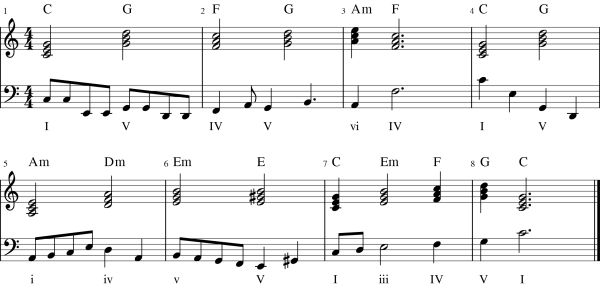Audio: pop chord progression (0:16)

pop chord progression plays chord progressions on a bass synth and an electronic drum kit. The pop chord progression figure shows the score:
A pop chord progression is a succession of pleasing sounds.
A chord in pop harmony is nonfunctional. It has no purpose, it just is. A chord can be complete or incomplete, any chord note can be doubled or tripled, the notes can be voiced in open or closed harmony, and a chord can be in root position, first or second inversion. There are no rules for voice leading.
Chords in pop harmony are used in any old way and there are no rules and no preferred order of chords in a pop chord progression.
A pop chord progression in a major key looks remarkably like a functional chord progression in major harmony. The three chords I, IV and V, known as the primary triads in functional harmony, are widely used in pop harmony, where they are fondly known as the famous three chord trick.
I-IV-V-I is a common chord progression in pop harmony. Its retrograde version, I-V-IV-I, is popular too. There are all sorts of variations, I-V-IV-V is used in bars 1-2 of pop chord progression.
Add the relative minor to the three chord trick and you are in pop harmony heaven. These four chords, I, IV, V and vi are widely used in pop harmony. Many pop songs are based on just these four chords. Again, there all sorts of ways to string the chords together. I-V-vi-IV is a common progression. vi-IV-I-V is used in bars 3-4 of pop chord progression and also appears in the second phrase of verse.
A pop chord progression in a minor key is similar to a functional chord progression in minor harmony. One difference is that pop harmony uses the natural minor scale as well as the melodic and harmonic minor scales. The i, iv, and v or V chords are the basis of many a minor chord progression. There is no preference between the v and V dominant chord, either can be used, a i-iv-v progression is as feasible as i-iv-V. Bars 5-6 of pop chord progression includes a i-iv-v-V progression to emphasise the different sound of the v and V dominant chord.
There are no rules for root motion in pop harmony. A chord can repeat as often as necessary. Root movement through the circle of fifths is common. vi-ii-V-I is a good example of a circle progression and I-vi-ii-V is an interesting variant. A step up, say, IV-V, is as common as a step down, V-IV. Root motion by third, though less used than other root motions, is always an option: it is shown in bar 3, vi-IV, and bar 7, I-iii, of pop chord progression.
A fixed tempo is a given in much pop harmony. A lot of pop music is for dancing to as well as for listening to and dancers need a regular rhythm. Quadruple meter, 4/4 time, is the default in much pop harmony, and is used in pop chord progression. Syncopation is widespread and is evident in the percussion rhythm pattern in pop chord progression and in the melody played by the bass part and the chords in the treble parts.
Harmonic rhythm is the rate at which chords change. It is a major factor in harmony. It is largely determined by the tempo. In functional harmony, the tempo is often slow, and a chord can change with every beat. In pop harmony, the tempo is often fast, and a chord changes every other beat, as in pop chord progression, or every bar, as in verse.
Altering and varying individual chords in a chord progression is perfectly OK. Any triad can be altered to form a suspended chord. Any triad can be extended at any time to form an add chord, a dominant seventh chord or a major or minor seventh chord.
There are plenty of chord progressions to explore in pop harmony. This list of chord progressions catalogues around twenty or so of the most popular.